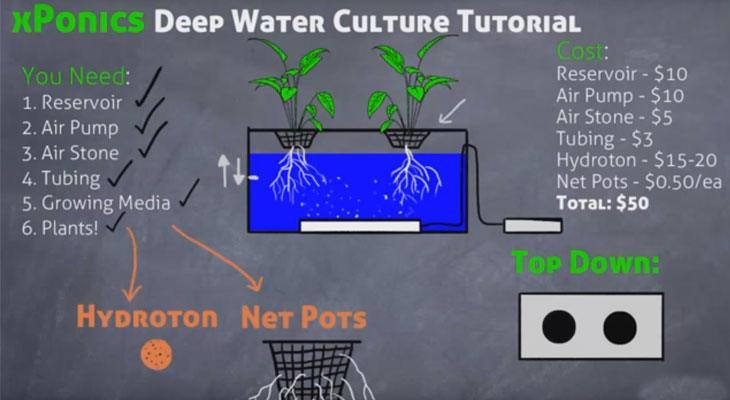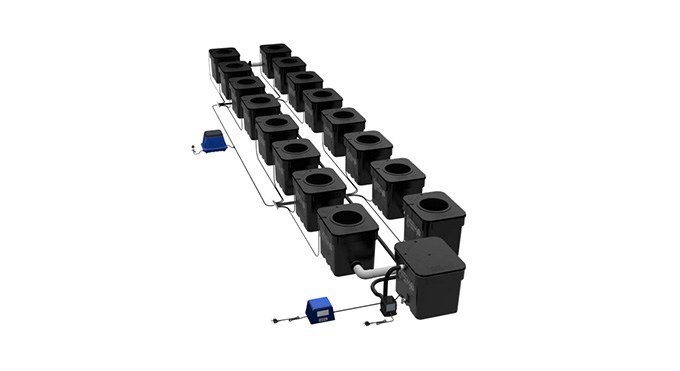If you’re new to growing plants hydroponically, words like “Deep Water Culture” can sound like they’re straight out of a science-fiction movie. Compared to soil gardening, hydroponics looks more complex – but it’s really not.
There are many types of hydroponic systems, many of which have confusing sounding names (nutrient film technique, deep water culture, ebb and flow). But that’s what this article is here for!
Let’s take a look at one of the simplest and most popular methods of hydroponic gardening today – Deep Water Culture, or DWC.
If you’re more of a visual learner (like me) you can check out this video I put together on my YouTube channel below. It gives you an overview of what’s going on in the system, and what you need to get started.
What Is Deep Water Culture (DWC)?
Before we get into the nitty gritty details, let’s get a high-level overview of this type of system. In a DWC system, a plant’s roots are suspended in a well-oxygenated solution composed of water and nutrients.
There are three critical parts of this solution:
- Oxygen: Because the roots are submerged in water and not soil (which has gaps and holes where air resides), the water needs to be well oxygenated so the plant doesn’t drown. This is accomplished with an air pump and air stone.
- Water: Think of this system as if you’re growing in soil and permanently watering your plants – this is one of the reasons growing hydroponically is so beneficial – you never need to ‘water’ again.
- Nutrients: A good quality soil contains all of the micro and macro nutrients that a plant needs to survive and thrive. Because we have no soil, we need to supplement the oxygen-rich water with nutrients so our plants can grow.
This method is called Deep Water Culture for two reasons. One, you typically grow with a reservoir that can hold a decent amount of water. More water means more stability in your nutrient solution, which means less monitoring and maintenance for you!
The second reason is because of how much of the root mass you submerge in the water. Other methods expose your plant’s root zone to air and drench them in water just a few times a day (ebb and flow systems are a good example of this). In deep water culture, most of your plant’s root system is submerged 24/7 – hence the name!
Listen to this post on the Epic Gardening Podcast
Subscribe to the Epic Gardening Podcast on iTunes or Spotify
Benefits of Deep Water Culture
DWC systems are popular for many different reasons, the primary one being that they’re one of the simplest types of systems to start with. The only system that is simpler is a wicking system.
Here are a few other benefits to growing in a DWC system:
- Very low maintenance once you set it up
- Extremely fast growing time compared to soil (I’ve grown lettuce to harvest in 30 days instead of 60 in soil)
- Very little moving parts and assembly
Downsides of Deep Water Culture
However, it’s not all sunshine and roses. There are some issues with this type of system that can cause you problems. These are mostly avoidable if you’re maintaining your garden, though:
- In small systems, pH, water level, and nutrient concentration may fluctuate wildly
- In small systems, opportunity to over or undercalibrate is VERY easy due to small scale
- If you have an electricity outage or a pump failure, your roots may “drown” in low-oxygen nutrient solution
- It can be difficult to maintain a consistent water temperature
Deep Water Culture Variations
The Traditional Method

Building a Deep Water Culture System
Traditional DWCs are the easiest to build. Here’s a list of the parts you’ll need to set up your first system:
- 5-gallon bucket
- Air pump
- Air stone
- Airline tubing
- Net pots
- Growing media
- Hydroponic nutrients
- pH control kit
- PPM meter
The method is simple: connect the pump to the tubing, the tubing to the airstone, and place the airstone in the bucket. Fill up the bucket with water, properly pH and add your nutrients, and start your seeds. (Both of those links are to great videos that go into a lot more depth!)
Once your plants start to germinate and the roots start to hit the water, you’ll see an explosion of growth. Instead of spending energy growing the roots to search for pockets of water in soil, your plants can simply suck up as much water and nutrients as they need right away.
If the water is properly oxygenated, there’s no reason why your plant’s roots can’t remain submerged deep in the water (hence the name) for the entire life cycle of the plant!.
Why It Works
Because of the highly oxygenated and nutrient-rich solution, plants grown in a traditional DWC system can be harvested up to twice as fast as normal soil-grown plants! I’ve personally harvested a head of lettuce in 30 days from germination
The fastest I’ve ever grown lettuce in soil is 60 days.
Recirculating DWC
The traditional method is amazing for beginners, but what if you want to scale your system to the next level? Most people move to a RDWC, or Recirculating Deep Water Culture system when they want to upgrade their garden.
If you’re looking to grow at scale, the last thing you want to do is have 10 individual buckets, all requiring their own calibration and adjustment. If you’re growing the same plant across 10 different buckets, doesn’t it make a lot of sense to have one main reservoir and feed that nutrient solution across all 10 buckets?
If you said yes…you just invented the RDWC system!
Here’s an example:

You’d have to have a love of torturing yourself to want to individually pH and calibrate each of these buckets!
You might be wondering how the oxygenation of the water occurs if you have multiple buckets chained together. Just as it would be inefficient to have separate nutrient solutions for each bucket, it’s also inefficient to run an airstone system for each bucket.
This is where the recirculating part of the name comes into play. As water moves from bucket to bucket, it’s shuttled around via spray nozzles that oxygenate the water.
The beauty of this modification to the classic DWC system is that you only have to calibrate, oxygenate, and add more water from one central location and it gets fed out to all buckets immediately. The best analogy here is the power grid: we don’t run our own generators in our homes. Power is generated from centralized locations and then ‘sent out’ through the power grid to our houses.
Bubbleponics
Although many people don’t consider Bubbleponics to be all that different that the traditional DWC, I personally think that it has a few advantages and is important enough to talk about. Despite its silly name, the adaptation that Bubbleponics makes is simple.
Instead of waiting for your plants to germinate and the roots to hit the top of the water in your reservoir, Bubbleponics aims to speed up that process by top-feeding the nutrient solution to your plants for the first few weeks.
All that’s going on here is the addition of a water pump to the system, with drip lines running up out of the tank to the net pots that your plants are sitting in. Simple, but very effective in speeding up the germination and seedling phase of a plant’s life cycle.
Common Deep Water Culture Questions (and Answers)
What type of nutrients should I use in my deep water culture system?
Companies offer a variety of hydroponic nutrients, so it can be hard to figure out which is best for you. In my opinion, it’s best to start out with something dead simple like the General Hydroponics Flora Series. It’s a three-part hydroponic nutrient that you mix in varying quantities based on your plant’s stage of growth.
Should I use a singular or modular system?
If you’re just starting out, go with a single reservoir setup. You can build them yourself or buy one of the many on the market. A modular DWC system is better for growers who know exactly what they want to grow and how much they want to grow. Start small and scale up as you get more experience.
Should my reservoir be sterile?
This is not a yes or no question. Some hydroponic gardeners want to keep their reservoir sterile. This means they won’t have any of the biological contaminants that might plague a hydroponic garden, like algae. But at the same time, they won’t be able to take advantage of beneficial bacteria. If you do decide to add beneficial biology to your reservoir, just be aware that it comes with the risk of having not-so-beneficial biological organisms tag along for the ride.
What should my pH and PPM / EC be for DWC?
Just because you’re growing in a deep water culture system doesn’t mean you need to adapt your pH and PPM / EC. The standard range that most plants prefer (pH 5.5-6.5) is fine, however you will want to customize and monitor this based on what stage of growth your plants are in. When they’re putting on vegetation, you want to keep your pH in the higher end of that range, and when they’re flowering, the lower end.
As far as your PPM / EC, don’t blindly follow the feeding schedule on the back of your hydroponic nutrients. They are typically higher than necessary. Try cutting that amount in half and seeing how your plants respond. You can always adjust upwards quickly, while adjusting downwards is more challenging as your plants may have already suffered from nutrient burn.
What should the temperature of my reservoir be?
This is one of the downsides of deep water culture: it can be hard to control the temperature of your reservoir. Aim for no higher than 68°F (20°C). If you get much higher, the oxygen level in your water starts to drop (even if you’re oxygenating with an air pump and air stone).
Also try to keep it above 60°F (16°C). If it goes any lower, your plants think that they’re moving into a new season, typically fall or winter. This means they’ll start to divert more energy towards flowering, which you may not want.
When should I change my nutrient solution?
The longest you should wait before changing out your solution is three weeks, but this is just a general case. It depends on:
- The type of plants you’re growing
- The stage of growth they’re in
- The size of your reservoir
If you want to avoid a complete change, you can try to add water with some nutrient solution mixed in to get the right balance again, but this is difficult to do. A complete change may be the better route.
How do I know how much oxygen is in my nutrient solution?
Dissolved oxygen meters are available for sale, but they’re pricy and might be overkill unless you want extreme precision. I wouldn’t recommend purchasing a lower-end one though — they’re not very reliable. The best way to “monitor” your dissolved oxygen levels is simply to do the things that ensure that levels are good, namely keeping the solution at the right temperature and running your air pump.
How much of the roots should be submerged in my DWC reservoir and nutrient solution?
First of all, make sure that only the root matter is submerged in your nutrient solution — no stem, and certainly no vegetation. You don’t want to completely submerge the roots, either. I personally keep about 1-1.5″ of root above the water line. The bubbles from the air stone will typically pop and water will still land on the roots that aren’t submerged, so you don’t have to worry about them drying out.
How would I propagate plants if I don’t want to use a growing media in my DWC system?
That’s easy — use an aeroponic cloner. You’ll save money on growing media and the plants that you propagate will have nothing but bare root when you transplant them into your DWC
Are there any deep water culture specific issues to watch out for?
Monitor your garden for the following issues, all of which are common in DWC systems:
- Root-related plant diseases like Pythium
- Rapid fluctuations in pH or PPM / EC / TDS
- Nutrient solution that is too warm
How much faster do plants grow in a DWC system?
Provided you’re doing everything right, plants grown in a DWC system (or most hydroponic systems) will grow at least 15% faster. I have seen my lettuce grow almost twice as fast in my deep water culture setup vs. my outdoor garden.
What plants grow best in a deep water culture system?
The obvious answer is anything that doesn’t have to flower. Many varieties of lettuce and lots of different herbs will work very well in DWC. They grow super-fast and healthy, making them a fantastic option. However, you can also grow tomatoes, peppers, and even larger fruits like squash…they just take a bit more effort.
Are there any other tricks available to the DWC grower?
A: Yes! DWC growers can easily manipulate the amount of moisture in the root zone. This, in turn, can trigger plant responses such as essential oil production, fruiting and flowering. A dryer root zone can increase essential oil production in aromatic crops such as basil and mint. (They do this as a means to conserve water.) A wetter root zone can cause plants to focus on vegetative production, particularly large fan leaves, which in turn speeds transpiration and photosynthetic potential.
Header photo courtesy of David Offutt over at Gastronomic Gardener.









